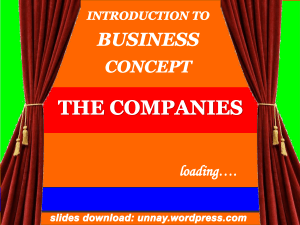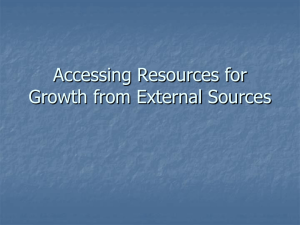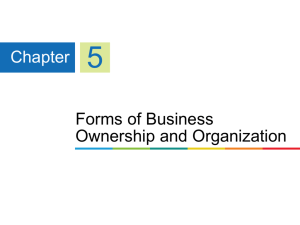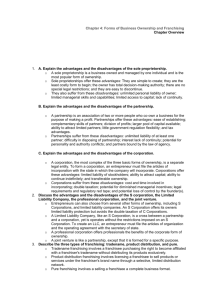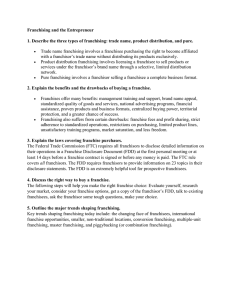Chapter 1:The Foundations of Entrepreneurship
advertisement
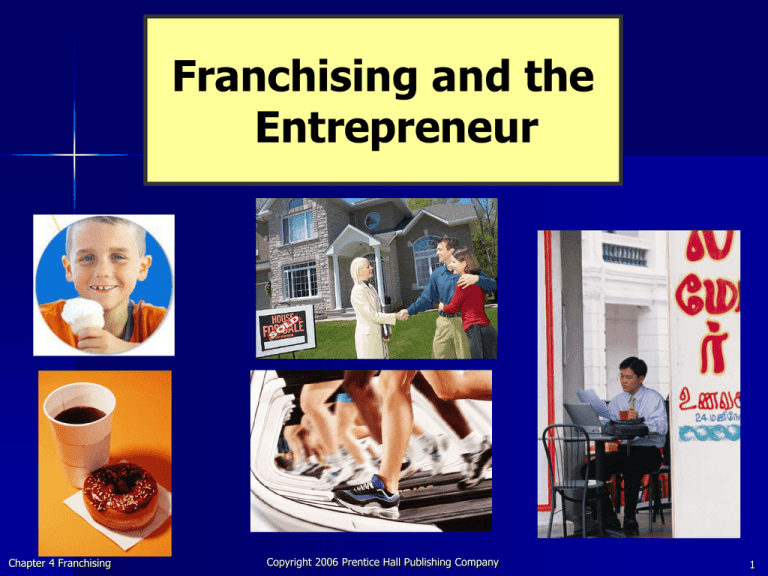
Franchising and the Entrepreneur Chapter 4 Franchising Copyright 2006 Prentice Hall Publishing Company 1 The Franchising Boom!!! Chapter 4 Franchising Sales exceeding $1 trillion from virtually every product or service imaginable. One out of 12 retail businesses in the U.S. is a franchised operation. Franchise sales account for 40% of total retail sales. A new franchise opens somewhere in the world every six-and-a-half minutes and in the United States every eight minutes. Copyright 2006 Prentice Hall Publishing Company 2 Franchising Grow th Num ber of Units (in Thousands) Number of Franchised Units (in Thousands) 400,000 341,579 350,000 300,000 337,693 351,459 310,044 290,605 274,265 250,000 200,000 150,000 100,000 50,000 2000 2001 2002 2003 2004 2005 Year Chapter 4 Franchising Copyright 2006 Prentice Hall Publishing Company 3 Franchising Chapter 4 Franchising Franchising – semi-independent business owners pay fees and royalties to a parent company in exchange for the right to sell its products and services under the franchiser’s trade name and often to use its business format and system. Copyright 2006 Prentice Hall Publishing Company 4 Types of Franchising Tradename Product distribution Pure (Business format) Chapter 4 Franchising Copyright 2006 Prentice Hall Publishing Company 5 Why Buy a Franchise? Chapter 4 Franchising Franchisees benefit from the franchiser’s experience. Franchisees get a proven business system and avoid having to learn by trial-and-error. Franchisees earn a great deal of satisfaction from their work. Before buying, ask: “What can a franchise do for me that I cannot do for myself?” Copyright 2006 Prentice Hall Publishing Company 6 Benefits of Franchising Business system Management training and support Brand name appeal Standardized quality of goods and services National advertising program Chapter 4 Franchising Copyright 2006 Prentice Hall Publishing Company 7 Benefits of Franchising Financial assistance Proven products and business formats Centralized buying power Site selection and territorial protection Greater chance for success Chapter 4 Franchising Copyright 2006 Prentice Hall Publishing Company 8 Drawbacks of Franchising Franchise fees and profit sharing Strict adherence to standardized operations Restrictions on purchasing Limited product line Unsatisfactory training programs Market saturation Less freedom Chapter 4 Franchising Copyright 2006 Prentice Hall Publishing Company 9 Ten Myths of Franchising 1. 2. 3. Chapter 4 Franchising Franchising is the safest way to go into business because franchises never fail. I’ll be able to open my franchise for less money than the franchiser estimates. The bigger the franchise organization, the more successful I’ll be. Copyright 2006 Prentice Hall Publishing Company 10 Ten Myths of Franchising 4. 5. 6. Chapter 4 Franchising I’ll use 80 percent of the franchiser’s business system, but I’ll improve upon it by substituting my experience and know-how. All franchises are the same. I don’t have to be a “hands-on” manager. I can be an absentee owner and be very successful. Copyright 2006 Prentice Hall Publishing Company 11 Ten Myths of Franchising 7. 8. 9. 10. Chapter 4 Franchising Anyone can be a satisfied, successful franchise owner. Franchising is the cheapest way to get into business for yourself. The franchiser will solve my business problems for me; after all, that’s why I pay an on-going royalty. Once I open my franchise, I’ll be able to run things the way I want to. Copyright 2006 Prentice Hall Publishing Company 12 What Do Franchisers Look for in a Franchisee? Yes No Maybe Experienced? Hard Working? Team Player? Leadership & Management Skills? Risk Averse? Educated? Financially Stable? A Desire to Succeed? What Do Franchisers Look for in a Franchisee? Yes No Maybe Experienced? Hard Working? Team Player? Leadership & Management Skills? Risk Averse? Educated? Financially Stable? A Desire to Succeed? What Do Franchisers Look for in a Franchisee? Yes No Maybe Experienced? Hard Working? Team Player? Leadership & Management Skills? Risk Averse? Educated? Financially Stable? A Desire to Succeed? What Do Franchisers Look for in a Franchisee? Yes No Maybe Experienced? Hard Working? Team Player? Leadership & Management Skills? Risk Averse? Educated? Financially Stable? A Desire to Succeed? What Do Franchisers Look for in a Franchisee? Yes No Maybe Experienced? Hard Working? Team Player? Leadership & Management Skills? Risk Averse? Educated? Financially Stable? A Desire to Succeed? What Do Franchisers Look for in a Franchisee? Yes No Maybe Experienced? Hard Working? Team Player? Leadership & Management Skills? Risk Averse? Educated? Financially Stable? A Desire to Succeed? What Do Franchisers Look for in a Franchisee? Yes No Maybe Experienced? Hard Working? Team Player? Leadership & Management Skills? Risk Averse? Educated? Financially Stable? A Desire to Succeed? What Do Franchisers Look for in a Franchisee? Yes No Maybe Experienced? Hard Working? Team Player? Leadership & Management Skills? Risk Averse? Educated? Financially Stable? A Desire to Succeed? What Do Franchisers Look for in a Franchisee? Yes No Maybe Experienced? Hard Working? Team Player? Leadership & Management Skills? Risk Averse? Educated? Financially Stable? A Desire to Succeed? Franchising and the Law Key protection is the Uniform Franchise Offering Circular (UFOC). Franchisers must deliver a copy of UFOC before any offer or sale of a franchise. Chapter 4 Franchising Copyright 2006 Prentice Hall Publishing Company 22 Franchising and the Law The UFOC contains information on 23 topics, including: Franchiser’s business experience Franchise fees and costs Lawsuits involving the franchiser Financial assistance available Territorial protection granted Restrictions on purchasing Chapter 4 Franchising Copyright 2006 Prentice Hall Publishing Company 23 Detecting Dishonest Franchisers Chapter 4 Franchising Claims that the contract is “standard; no need to read it.” Failure to provide a copy of the required disclosure documents. Marginally successful prototype or no prototype. Poorly prepared operations manual. Unsolicited testimonial from “a highly successful franchisee.” Copyright 2006 Prentice Hall Publishing Company 24 Detecting Dishonest Franchisers (Continued) Chapter 4 Franchising Unusual amount of litigation by franchisees. Promises of future earnings with no documentation. High franchisee turnover or termination rate. Attempts to discourage your attorney from evaluating the contract before signing it. Copyright 2006 Prentice Hall Publishing Company 25 Detecting Dishonest Franchisers (Continued) Chapter 4 Franchising No written documentation. High pressure sale. Claims to be exempt from federal disclosure laws. "Get rich quick" schemes, promising huge profits with minimal effort. Reluctance to provide a list of existing franchisees. Evasive, vague answers to your questions. Copyright 2006 Prentice Hall Publishing Company 26 How to Buy a Franchise Chapter 4 Franchising Preparation, common sense, and patience are vital ingredients in choosing the right franchise. Evaluate yourself - What do you like and dislike? Research the market. Consider your franchise options. Get a copy of the franchiser’s Uniform Franchise Offering Circular (UFOC) and study it. Copyright 2006 Prentice Hall Publishing Company 27 What Should You Look For? A unique concept or marketing approach Profitability A registered trademark Chapter 4 Franchising Copyright 2006 Prentice Hall Publishing Company 28 What Should You Look For? (Continued) A business system that works A solid training program Affordability A positive relationship with franchisees Chapter 4 Franchising Copyright 2006 Prentice Hall Publishing Company 29 How to Buy a Franchise (Continued) Talk to existing franchisees. Ask the franchiser some tough questions. Make your choice. Chapter 4 Franchising Copyright 2006 Prentice Hall Publishing Company 30 Table 4.4 Advantages and Disadvantages of Buying a New vs. an Established Franchise New Franchise Established Franchise Pros Cons Can be new and exciting Business concept can be fresh and different in the market Possibility of getting lower fees as a “pioneer” of the concept Potential for a high return on investment Business is not tested or established in the market Unknown brand and trademark Possibility that the concept is a fad with no staying power Franchiser may lack the experience to deliver valuable services to franchisees Business concept likely is wellknown to consumers and market for the products or services is already established. Franchiser has experience in delivering services to franchisees Franchiser has had time to work the “bugs” out of the business system High franchise fees and costs that often are non-negotiable Concept may be on the wane in the market Franchiser’s brand and trademark may remind customers of an outdated concept Franchiser’s “trade dress” may be in need of updating and redesigning Source: Based on Andrew A. Caffey, “Age Issues,” Entrepreneur, January 2002. p. 118. Franchise Contracts 40% of New Franchisees Sign Contracts Without Reading Them !!! Note clauses covering: Termination Renewal Transfers and Buybacks Chapter 4 Franchising Copyright 2006 Prentice Hall Publishing Company Contract 32 Trends Shaping Franchising Chapter 4 Franchising International opportunities Smaller, nontraditional locations Conversion franchising Multiple-unit franchising Master franchising Piggybacking (Combination franchising) Serving aging baby boomers Copyright 2006 Prentice Hall Publishing Company 33 Franchising Web Sites Entrepreneur’s Franchise Zone http://www.entrepreneur.com/Franchis e_Zone/FZ_FrontDoor/0,4670,,00.html Subway Sandwiches and Salads http://www.subway.com/ Auntie Anne’s Pretzels http://www.auntieannes.com/ Chapter 4 Franchising Copyright 2006 Prentice Hall Publishing Company 34
